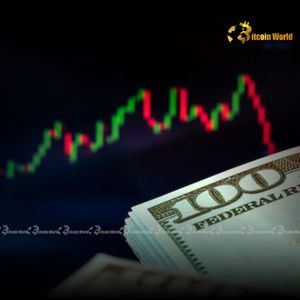BitcoinWorld Dollar Decline: Unveiling Crucial Shifts in the Forex Market Even in the dynamic and often unpredictable world of cryptocurrencies, understanding traditional financial markets, especially major currency trends , is absolutely crucial. The recent and significant Dollar decline against a basket of major currencies, particularly the Euro, serves as a powerful reminder of how macroeconomic shifts can send ripples across all asset classes, including the digital ones. What does this mean for your portfolio, and how are these shifts reshaping the global economy ? Why is the Dollar Experiencing a Significant Decline? The mighty US Dollar, long considered a safe haven and the world’s primary reserve currency, has been on a noticeable downward trajectory. This isn’t a random fluctuation; rather, it’s the culmination of several interconnected factors influencing the Forex market . Investors are closely scrutinizing central bank policies, inflation data, and the overall economic outlook, all of which are contributing to the Dollar’s current weakness. Several key elements are at play: Shifting Interest Rate Expectations: The Federal Reserve’s aggressive rate-hiking cycle, which bolstered the Dollar for much of the past year, appears to be nearing its peak. Markets are now pricing in fewer future rate hikes, and even potential cuts, as inflation shows signs of cooling. This reduces the Dollar’s yield advantage compared to other currencies where central banks are still in tightening mode. Inflation Dynamics: While US inflation remains elevated, the pace of increases has slowed. This could alleviate pressure on the Fed to maintain a highly hawkish stance, leading to a less attractive carry for the Dollar. Economic Growth Concerns: Worries about a potential recession or significant economic slowdown in the United States are weighing on investor sentiment. A weaker economic outlook can deter foreign investment, thereby diminishing demand for the Dollar. Risk Appetite Return: As global economic fears somewhat subside and optimism about China’s reopening grows, investors are showing a greater appetite for riskier assets. This often leads to a rotation out of safe-haven currencies like the Dollar. To illustrate the factors contributing to the Dollar decline , consider the following: Factor Impact on USD Explanation Federal Reserve Policy Negative Anticipation of a dovish pivot or pause in rate hikes reduces the Dollar’s yield appeal. US Economic Data Negative Weaker-than-expected jobs or GDP figures signal a slowdown, reducing demand for the Dollar. Global Risk Sentiment Negative Increased global optimism encourages investors to move away from safe-haven assets like the USD. Inflation Trends Negative Signs of decelerating inflation may prompt the Fed to ease its tightening stance sooner. What’s Fueling the Euro Strength and Demand? In stark contrast to the Dollar decline , the Euro has experienced a remarkable resurgence, finding significant demand across the Forex market . After a challenging period marked by energy crises and inflation concerns, the single currency is now benefiting from a confluence of positive developments. This newfound Euro strength is a key driver in the broader shift in currency trends . Here’s why the Euro is gaining traction: European Central Bank (ECB) Hawkishness: Unlike the Fed, the ECB is still firmly in tightening mode. With inflation remaining stubbornly high in the Eurozone, the ECB has signaled its commitment to further significant rate hikes. This aggressive stance makes Euro-denominated assets more attractive for yield-seeking investors. Improving Economic Outlook: Despite earlier fears, the Eurozone economy has shown surprising resilience. Energy prices have eased considerably, and the bloc has managed to avoid a severe recession, boosting confidence in the region’s economic stability. Reduced Energy Concerns: The milder winter and successful efforts to diversify energy supplies have significantly reduced the immediate threat of an energy crisis in Europe. This has removed a major overhang for the Euro. Positive Capital Flows: As investor sentiment improves towards Europe, capital is flowing back into the region, supporting the Euro. This includes foreign direct investment and portfolio inflows. The Euro strength is not just a reflection of Dollar weakness; it’s a testament to the Eurozone’s improving fundamentals. The market is increasingly optimistic about the region’s ability to navigate current challenges and deliver growth. How are these Currency Trends Impacting the Forex Market? The interplay between the Dollar decline and Euro strength is creating significant volatility and new opportunities within the broader Forex market . The EUR/USD currency pair, the most traded pair globally, is a direct reflection of these shifting dynamics. As the Euro gains ground against the Dollar, it signals a recalibration of global financial power and investor confidence. These evolving currency trends have several implications: EUR/USD Rally: The primary consequence is the robust rally in the EUR/USD pair, which has climbed significantly from its multi-decade lows. This upward momentum is expected to continue as long as the underlying factors of Dollar weakness and Euro strength persist. Impact on Other Currencies: The Dollar’s broad weakness often provides breathing room for other major currencies, such as the British Pound (GBP) and the Japanese Yen (JPY), allowing them to regain some lost ground. Emerging market currencies also tend to perform better when the Dollar is weaker, as it eases debt burdens denominated in USD. Commodity Prices: A weaker Dollar generally makes dollar-denominated commodities, like oil and gold, cheaper for holders of other currencies, potentially boosting their demand and price. This is a crucial factor for the global economy . Investor Positioning: Traders and institutional investors are actively adjusting their positions, unwinding long Dollar bets and building up long Euro positions. This shift in sentiment can create self-reinforcing trends in the short to medium term. What Does This Mean for the Global Economy? The significant shifts in currency trends , particularly the Dollar decline and Euro strength , have far-reaching consequences for the entire global economy . These currency movements influence trade balances, corporate earnings, inflation, and investment flows, affecting nations and businesses worldwide. Key impacts on the global economy include: Trade Dynamics: A weaker Dollar makes US exports cheaper and more competitive globally, potentially boosting American industries. Conversely, it makes imports more expensive, which could contribute to domestic inflation. For the Eurozone, a stronger Euro makes their exports more expensive but imports cheaper, potentially easing inflationary pressures from imported goods. Corporate Earnings: Multinational corporations with significant international operations are directly impacted. US companies with overseas earnings will see those earnings translate into fewer Dollars when the Dollar is weaker. European companies, on the other hand, might see their foreign earnings boosted when converted back to a stronger Euro. Inflationary Pressures: A weaker Dollar can contribute to imported inflation in the US, as goods purchased from abroad become more expensive. For the Eurozone, a stronger Euro can help to dampen imported inflation, a welcome development for the ECB in its fight against rising prices. Debt Burdens: Many developing nations and corporations hold Dollar-denominated debt. A weaker Dollar eases the burden of servicing this debt, as it requires less local currency to repay. This can provide much-needed relief to economies under financial strain. Investment Flows: The relative strength of currencies can influence where international capital flows. A stronger Euro might attract more foreign direct investment into the Eurozone, while a weaker Dollar might make US assets less appealing to some foreign investors. These currency shifts underscore the interconnectedness of the global economy , where one nation’s currency movements can send ripple effects across continents, influencing everything from the price of consumer goods to the profitability of multinational corporations. Navigating the Shifting Sands: Actionable Insights and Challenges For investors, businesses, and even individuals, understanding these major currency trends is paramount. The Dollar decline and the rise of Euro strength present both challenges and opportunities that require careful consideration. The Forex market is dynamic, and staying informed is key. Challenges to Consider: Volatility: While the trend seems clear, currency markets can be highly volatile. Unexpected economic data, geopolitical events, or central bank interventions can cause sharp reversals. Uncertainty: The path of inflation and central bank policies remains uncertain. Any significant deviation from current expectations could alter the currency landscape. Hedging Costs: Businesses involved in international trade need to manage currency risk. The cost of hedging can fluctuate with market volatility. Actionable Insights for Navigating the Trends: Diversify Portfolios: Consider diversifying investments across different currencies and regions to mitigate risk. Assets denominated in stronger currencies like the Euro might offer better returns. Monitor Central Bank Commentary: Pay close attention to statements from the Federal Reserve and the European Central Bank. Their guidance on interest rates and economic outlook will be crucial in determining future currency movements. Re-evaluate International Exposures: For businesses, it’s a good time to re-evaluate pricing strategies, supply chains, and hedging policies in light of the changing currency landscape. Consider Commodity Exposure: Given the potential for commodity prices to rise with a weaker Dollar, certain commodity-related investments could offer a hedge or opportunity. Stay Informed on Global Economy: Keep a close eye on global economic indicators, especially from major economies like China and Europe, as their performance can influence overall risk sentiment and currency flows. Conclusion: A New Era for Global Currencies The ongoing Dollar decline and the surging Euro strength mark a pivotal moment in the Forex market , reshaping fundamental currency trends that will impact the entire global economy . This isn’t merely a cyclical adjustment but potentially a structural shift influenced by diverging monetary policies, evolving economic resilience, and a recalibration of investor confidence. While the Dollar may still reclaim some ground, the current trajectory suggests a more balanced multi-polar currency environment could be emerging. Understanding these profound shifts is essential for anyone navigating the complexities of global finance, from institutional investors to cryptocurrency enthusiasts, as the ripple effects will be felt across all asset classes and international trade. Staying agile and informed will be key to capitalizing on the opportunities presented by this fascinating period of currency realignment. To learn more about the latest Forex market trends, explore our article on key developments shaping the US Dollar, Euro, and interest rates, influencing global liquidity and institutional adoption. This post Dollar Decline: Unveiling Crucial Shifts in the Forex Market first appeared on BitcoinWorld and is written by Editorial Team



















